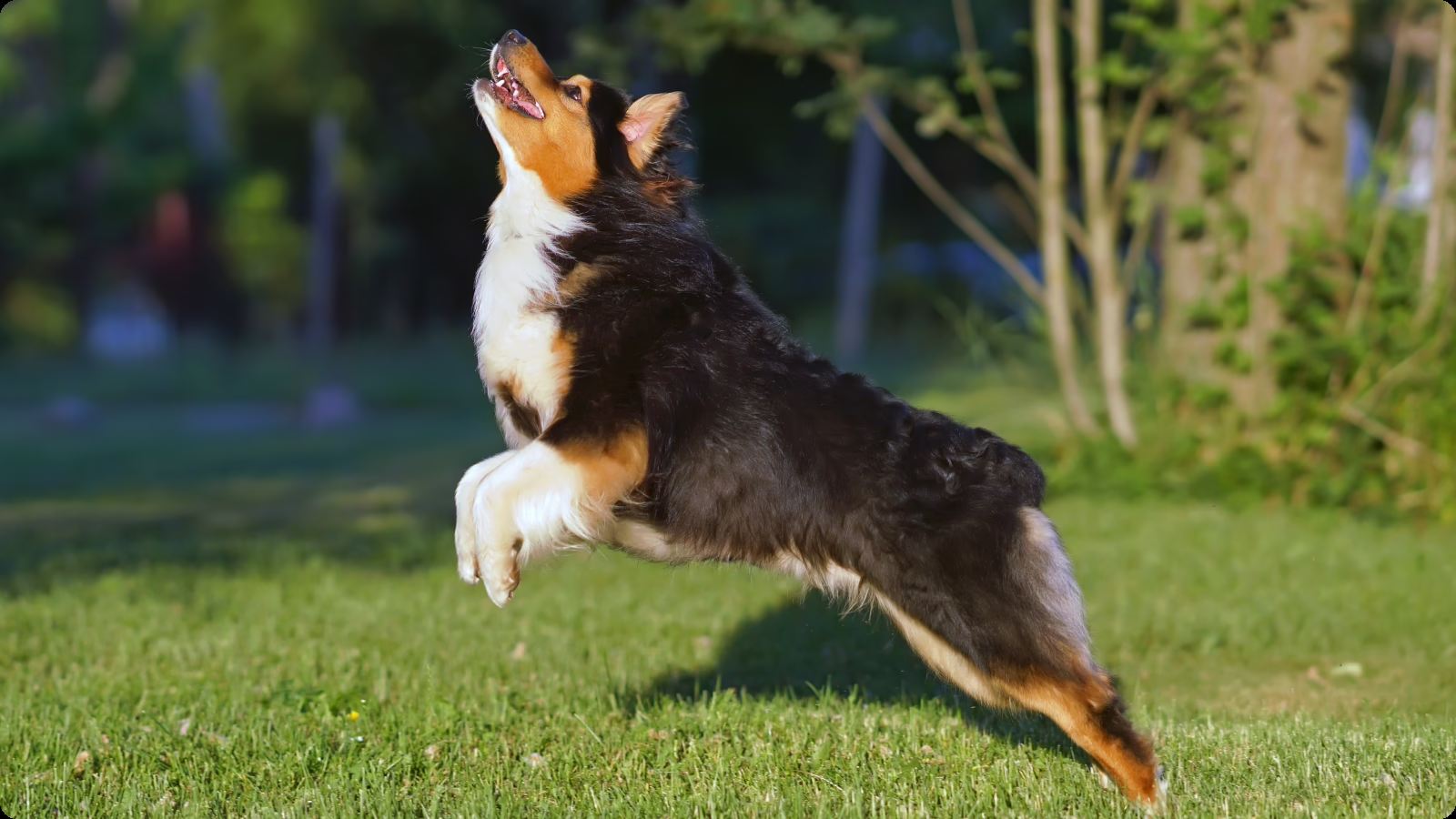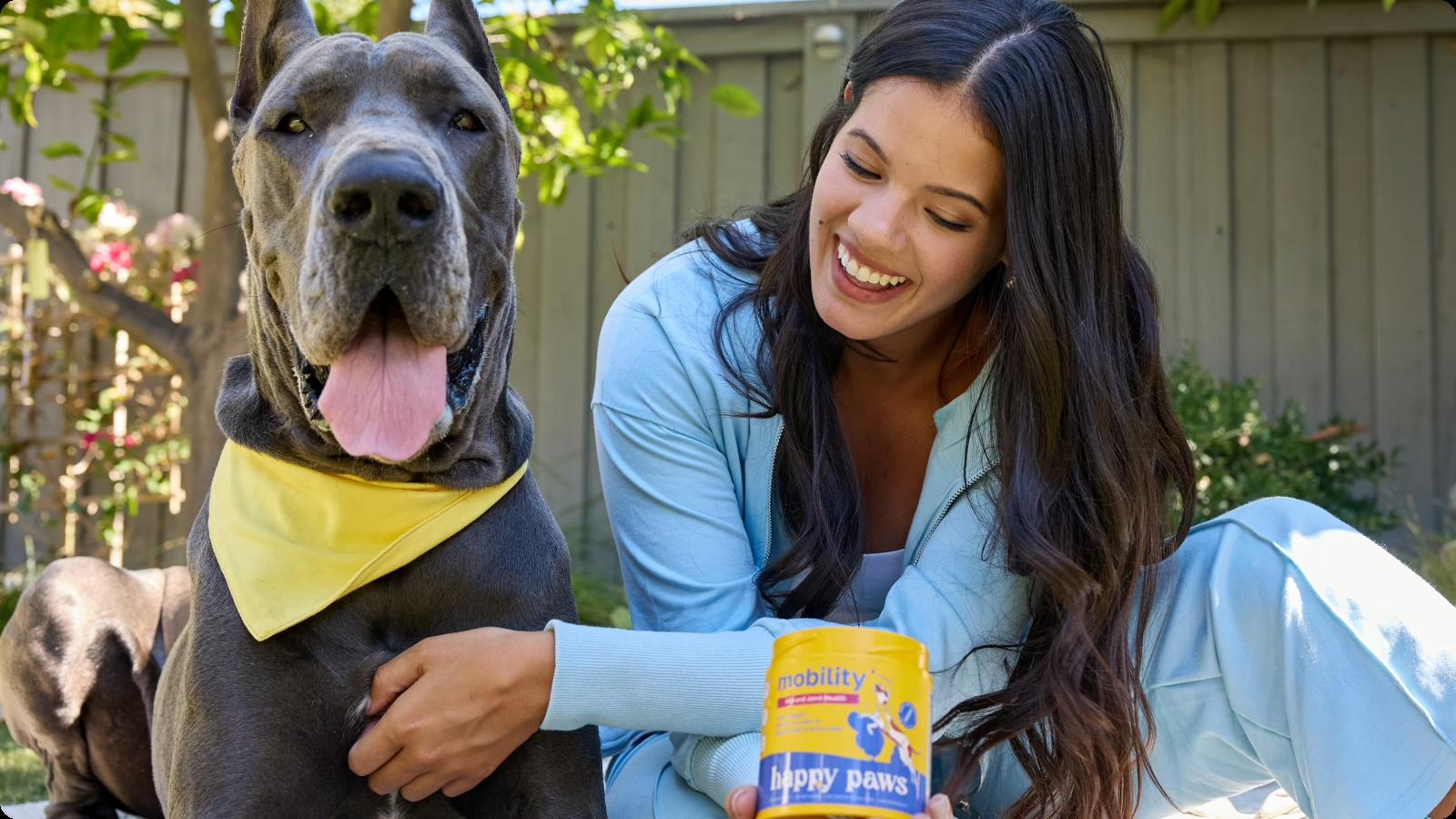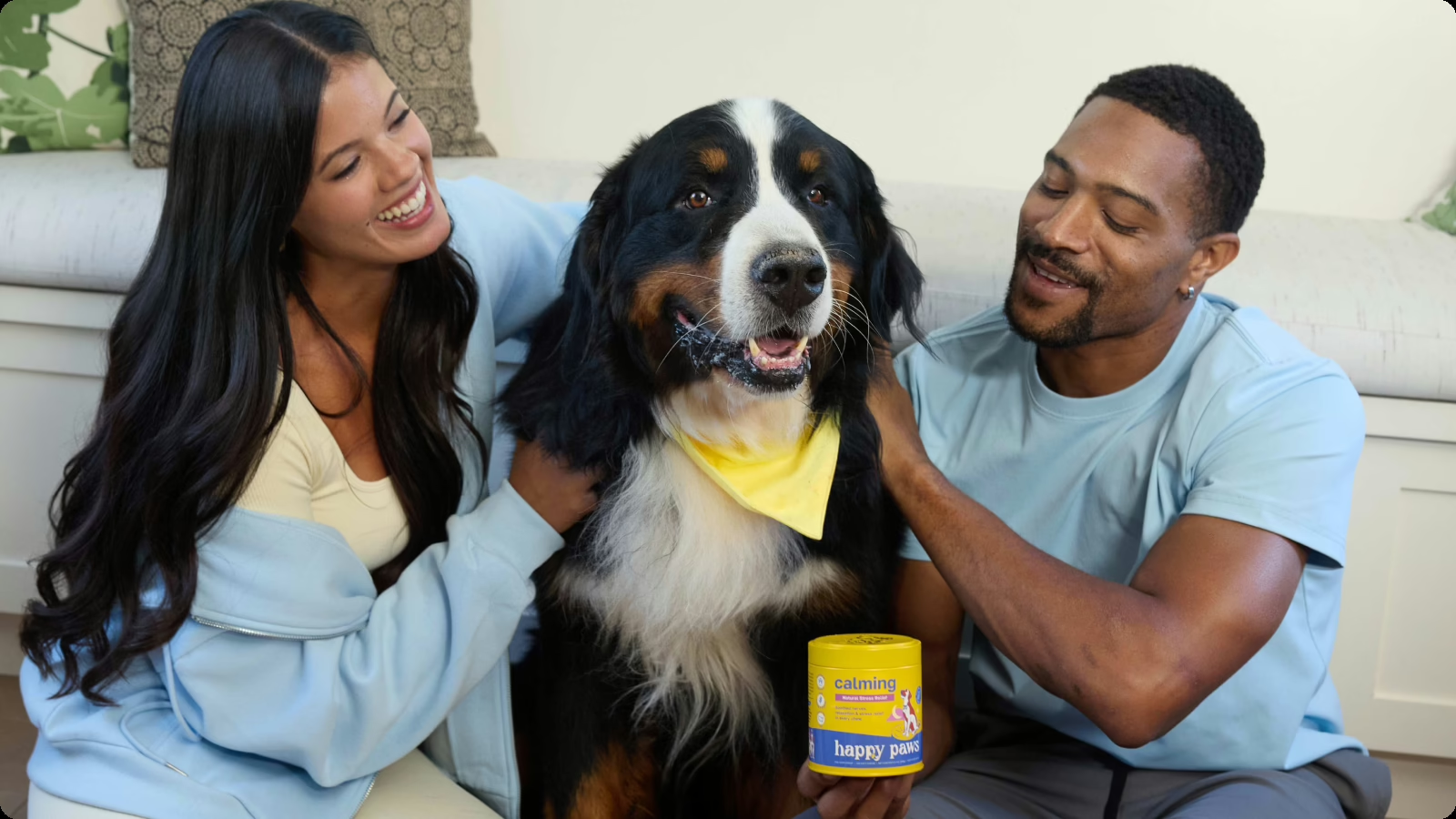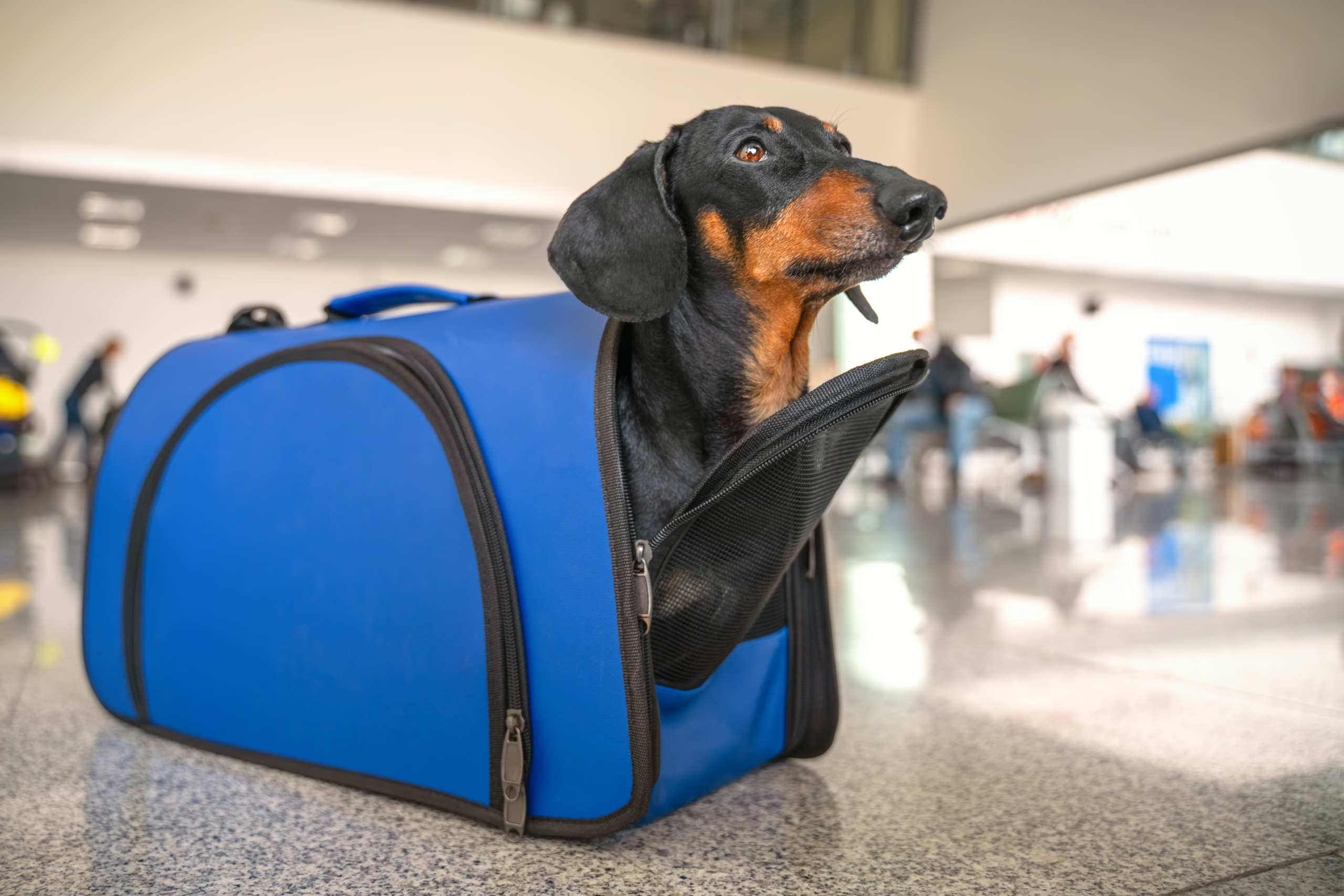Dog anxiety is normal, natural, and even expected, especially in younger pups. Imagine a newborn puppy first setting out into the unknown, wide-eyed and tongue-tied, tagging along beside their trusted hero (you). They’re excited, if not overly eager, to be next to you, happy to be included. But as new situations, experiences, and people start to bombard them, that little confident canine can grow fearful. The doorbell raises their hackles; the ironing board makes ’em scurry; and balloons can trigger intense fear. So, it’s important to know how to calm an anxious dog.
Just like with us, fear precedes bravery. Overcoming fear helps dogs build coping skills. But for many dogs growing up in an unknown world, that fear can sometimes feel overwhelming.
In this guide, we’re going to break down the common misconceptions about your dog’s struggle with anxiety. We’ll explore seven natural ways to soothe your dog’s worries and boost their intrinsic confidence. All you’ll need is a handful of treats, a little love, and a lot of patience. Training a dog to break out of their anxious tendencies is possible, but you’ll need a large helping of gentle patience.
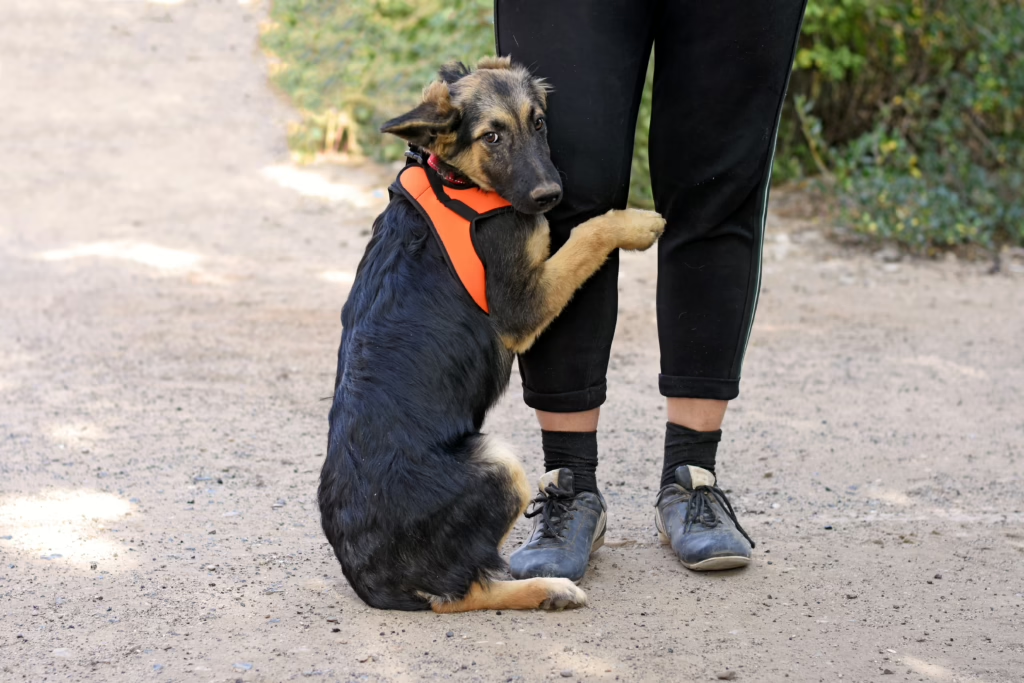
How Common Is Anxiety in Dogs?
Anxiety in dogs is more common than you’d think. In one 2020 study, researchers found that around 72.5% of dogs displayed some form of anxious behaviors, like excessive barking, accidental urination or defecation, and destructive actions. For parents of anxious pups, this might give you some relief. Anxious pups are more common than you’d think. And calming these habits may even be a little easier than you’d guess.
Signs of Dog Anxiety
For millennia, we’ve read our dog’s minds by analyzing their behavior. (If only they could talk!) A relaxed dog will lounge, a playful dog will roll over, a happy dog will wag their tail, and an anxious dog will go off-script. Anxiety in dogs looks the same, regardless of breed, age, or size. Here are a few tell-tale signs your dog is feeling stressed:
- Constant licking: Licking is a natural way for your dog to calm themselves down. But many dogs can overdo it, leading to incessant licking of their coat to the point of skin irritation. If your dog is constantly licking, consult a veterinarian. Licking may also indicate allergies or an overactive immune system.
- Incessant barking: An anxious dog will bark to alert you of any danger. But, when this danger stems from the mailman or a noisy car alarm, this barking is more hindering than helpful.
- Destructive behaviors: A nervous dog may have so much pent-up energy that they may chew on household items, like the couch cushion. This may also be a symptom of boredom, so keeping your dog mentally engaged throughout the day is essential. We’ll discuss specific strategies below.
- Accidental urination or defecation: Anxiety can cause a well-trained, house-broken dog to lose control of their faculties, resulting in a little in-door accident.
- Panting: Since dogs don’t sweat, they pant to cool themselves down. But when they’re anxious and overstimulated, dogs also pant to help self-soothe themselves. So, for instance, if your dog pants when you get home from work, this may be a sign that they’re feeling anxious.
- Pacing: Not being able to relax is a common sign of anxiety in dogs. Stressed-out dogs can pace for hours on end, refusing to sit or relax until the cause of their anxiety has been handled, like when the frightening balloon has been finally exiled once and for all.
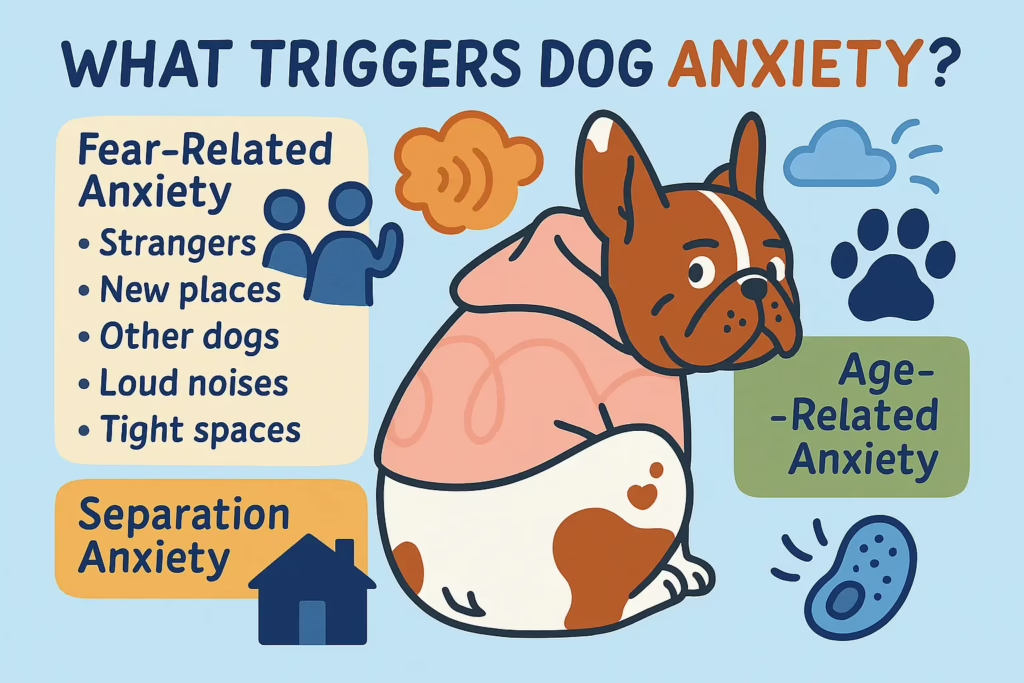
What Triggers Dog Anxiety
While each dog has their own individual triggers, there are three main types of anxiety in dogs.
Fear-Related Anxiety
First, we have fear-related anxiety. This type of anxiety stems from novel and learned experiences. Maybe your dog is at a new park, fearful of what lurks just behind the trees. Or you’re at a familiar park where an unfortunate event unsettled your dog’s nerves in the past, such as noisy or unusual events. Fear-related anxiety can include:
- Strangers
- New places
- Other dogs
- Loud noises
- Tight spaces
Separation Anxiety
Especially in a post-pandemic world, our dogs had to learn that we don’t usually spend every waking moment at home with them—and many dogs had to learn that fast. Separation anxiety is one the most common forms of anxiety, affecting up to 14% of all dogs. This fear in dogs stems from being left home alone. Dogs are pack animals. When they feel abandoned by their pack, dogs can become nervous and jittery, and while it may sound a little dramatic, leaving them behind for a few hours can lead to visible signs of distress.
Age-Related Anxiety
As dogs age, their cognitive health starts to decline, as does their sight and hearing. While these changes are oftentimes normal in older dogs, older dogs may not understand these changes. Their confusion may manifest in frightful anxiety. So, if you have an older dog who’s displaying unusual signs of anxiety, it may be related to changes with aging. It’s always best to consult your veterinarian about appropriate next steps throughout your dog’s golden years.
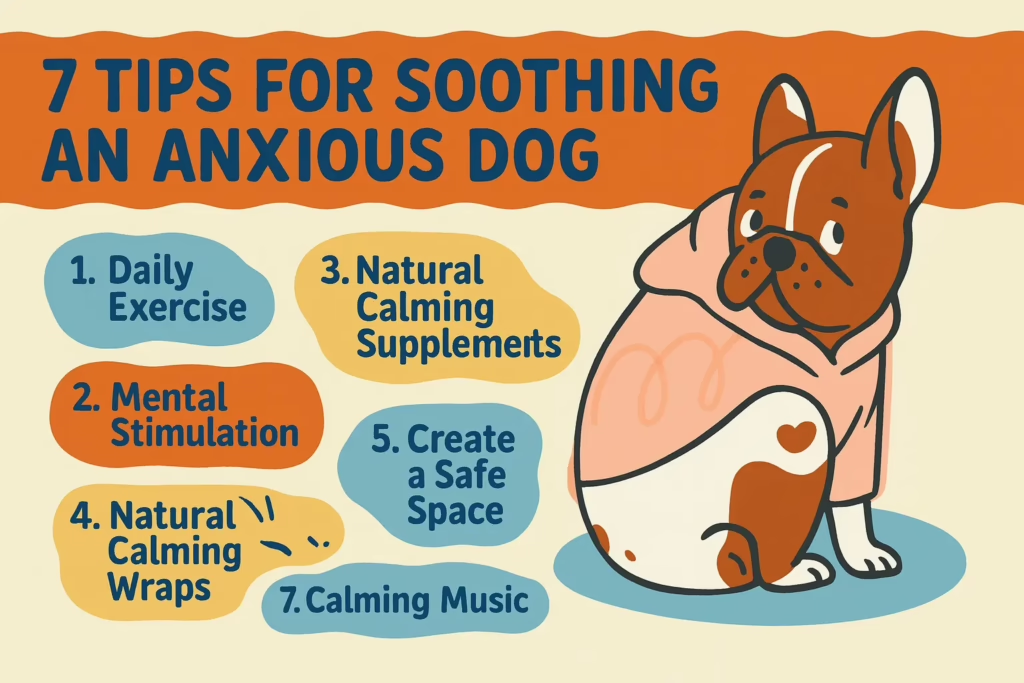
7 Holistic Ways to Help
Inside every dog is a curious, confident canine. But channeling that side of them needs nurturing, patience, and guidance. Here are seven ways to help naturally calm your dog and tap into their curious, confident side.
1. Daily Exercise
For many dogs, their anxiety stems from an abundance of energy with no viable outlets. Daily exercise can help your dog reduce anxiety through physical activity. You can take your dog on longer walks, occasional runs, and even involved playtime, like tug-of-war and fetch. Just like with us, exercise helps your dog exert their energy, helping them feel more relaxed and calm when triggers arise. Plus, it gives you a few extra minutes every day to connect with your pupper.
2. Mental Stimulation
Games and activities that fuel your dog’s brain can also curb boredom: a common cause of anxiety. Toys like snuffle mats and mental enrichment mats let your dog engage their cognitive abilities and exercise their nose, which is crucial for physical and psychological growth. If you don’t have a mentally stimulating toy handy, you can fold some treats into a towel, twist it, and tie the ends closed. The scent from the treats will captivate your dog’s nose, while the tied-up towel will serve as a mentally engaging activity.
3. Natural Calming Supplements
Another popular, all-natural option is organic calming dog supplements. These healthy treats come packed with naturally soothing ingredients, like tryptophan, L-theanine, and valerian root. Calming dog supplements typically come in perfectly measured chews, so you can give your dog an exact dose based on their size.
4. Create a Safe Space for Your Dog
Next, to help soothe your dog’s anxiety, it’s important to give them a safe, reliable home base to retreat to. When anxious, dogs may try to hide away from their trigger in different nooks and crannies. Dogs may hide under furniture or in enclosed spaces. While these dogs may feel safer in these areas, they aren’t the safest options.
Instead, train your dog to retreat to one safe space when they feel anxious, like a crate or a doggy mat. Be sure to help your dog associate this space with love, warmth, and good vibes. So, that means don’t use this space for time-out or punishment. Also, this space should be only for your dog—no one else. (The cat can have another spot to lounge.)
5. Desensitization Training
A popular intervention method for dog anxiety is desensitization training, which pet parents typically do with an experienced dog trainer or try out independently. Desensitization training is when you gradually expose your dog to their anxious triggers over time, helping them overcome their fear in a safe environment.
For instance, if your dog has separation anxiety when you leave them home alone, try just being gone for a little while and coming back. You can give your dog treats before you leave (not after) so they associate you leaving with something they love. Then, as you continually practice this training technique, you can gradually increase your absence time.
6. Chest Pets and Calming Wraps
Many anxious dogs respond positively to pressure on their chest and around their torso. Products like calming wraps can naturally cue the dog’s brain to help dogs relax during stressful events. If you don’t have a calming wrap handy, you can give your dog pets on their chest and torso, gently calming them down. Try not to pet your dog’s head when they’re anxious. They may see it as an invitation to play, which can only spiral their anxiety more.
7. Calming Music
If your dog fears loud noises, you can reduce external noise exposure with white noise and ambient sounds. Calming music can envelop your home in a more relaxing tone, letting your dog focus on those sounds, rather than the ones from outside. Many pet parents even leave the television on for dogs when they leave, all to drown out the racket from traffic and neighborhood noise.
Spotlight on Calming Dog Chews
In step three, we mentioned how many dog parents opt for all-natural calming supplements. Our Calming Dog Chews contain organic, vegan ingredients that support calm behavior using natural ingredients. You can give these chews to your dog to help support a daily sense of calm or whenever anxious triggers arise. These healthy treats are packed with top-shelf compounds, like tryptophan, valerian root, and L-theanine, each ingredient offering its own unique benefits for soothing stress and calming your dog’s jitters.

Consistency Is Key
The best course of action with this list is to pick one or two options and use them consistently for several weeks. Remember to start slow and gradually work these techniques into your dog’s daily routine. Over time, and with enough consistent practice, your dog may begin to lean on these techniques when their anxiety spikes.
If you believe your dog’s anxiety is out of your control, it’s always best to consult a veterinary professional. They can pinpoint your dog’s unique needs and build a road map to help address their triggers.
Parting Thoughts
Dog anxiety is more common than you’d think. Every day, dogs have to maneuver through a world that isn’t quite set up for their success. But at home, you can create a safe space for your dog to feel calm and confident. And with these seven strategies, you have actionable steps that you can take daily, all to help you tap into your dog’s curious, confident side.

